Welcome to the nutritional aspartic acid content in 3 different types of pigeon, ranging from 2.15 g to 0.67 g per 100g. The basic type of pigeon is Pigeon peas (red gram), mature seeds, raw, where the amount of aspartic acid in 100g is 2.15 g. For a typical serving size of 1.000 cup (or 205.00 g) the amount of Aspartic acid is 4.41 g.
Pigeon peas (red gram), mature seeds, raw - Nutritional Content and Chart
The full nutrition content, RDA percentages and levels for Pigeon peas (red gram), mature seeds, raw should be considered along with the aspartic acid content. This food profile is part of our list of food and drinks under the general group Legumes and Legume Products.Other important and aspartic acid related nutrients are Energy, Protein, Total Fat and Carbohydrate. For this 100g serving in your diet, the amount of Energy is 343.00 kcal (17% RDA), the amount of Protein is 21.70 g (39% RDA), the amount of Total Fat is 1.49 g (2% RDA) and the amount of Carbohydrate is 62.78 g (48% RDA). The nutritional content and facts for 100g, which includes Energy, Protein, Total Fat and Carbohydrate is shown in the RDA chart below as percentages of the recommended daily allowance along with the aspartic acid levels in pigeon.
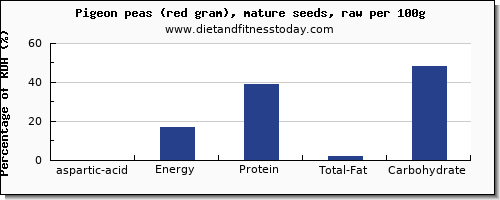
Our proprietary nutritional density score gives a nutritional value out of 100 based on 9 different vitamins, minerals and macro nutrients. Pigeon peas (red gram), mature seeds, raw has a nutritional value score of 16.00 out of 100.
Amount of aspartic acid per 100 Calories
100 calories of pigeon peas (red gram), mature seeds, raw is a serving size of 0 g, and the amount of Aspartic acid is 0 g. Other important and related nutrients and macronutrients such as Total Fat, in 100 Calories are as follows; Energy 0 kcal (0% RDA), Protein 0 g (0% RDA), Total Fat 0 g (0% RDA), Carbohydrate 0 g (0% RDA). This is shown in the aspartic acid RDA percentage chart below, based on 100 Calories, along with the other important nutrients and macro nutrients.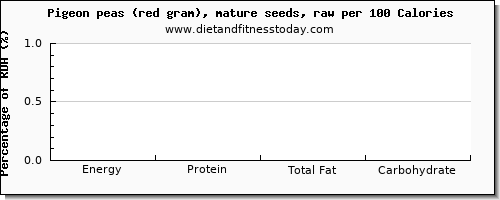
Content per Typical Serving Size 1.000 cup (or 205.00 g)
For the food Pigeon peas (red gram), mature seeds, raw the typical serving size is 1.000 cup (or 205.00 g) which contains 4.41 g of Aspartic acid. In terms of the gram weight and total content for this serving the Energy content is 703.15 kcal, the Protein content is 44.49 g, the Total Fat content is 3.05 g and the Carbohydrate content is 128.7 g. The percentages are shown below in the aspartic acid chart, for the typical serving of aspartic acid and the related and important nutritional values.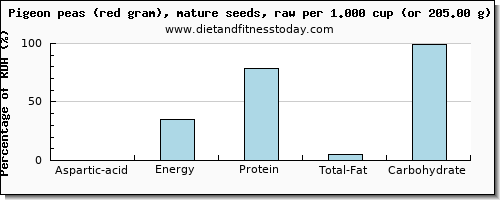
Macronutrients in Pigeon peas (red gram), mature seeds, raw
The amount of protein, fat and carbs from this food described above is measured in grams per 100g and grams in a typical serving size (in this case 1.000 cup or 205.00 g), although it is also useful to give the number of calories from protein, fat and carbohydrate which are the most important macronutrients. For this serving in your diet here are the macronutrient calories. From protein the number of calories is 154.4 (kcal).The total calories from carbohydrate is 523.8 (kcal).
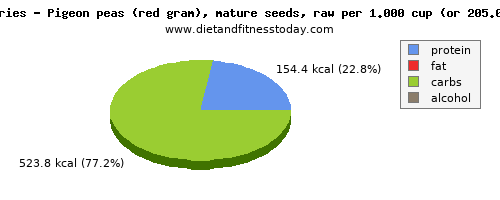
Grams of aspartic acid in pigeon (per 100g)
This list of 3 types of pigeon, is brought to you by www.dietandfitnesstoday.com and ranges from Pigeon peas (red gram), mature seeds, raw through to Pigeon peas (red gram), mature seeds, cooked, boiled, with salt where all food items are ranked by the content or amount per 100g. The nutritional aspartic acid content can be scaled by the amount in grams, oz or typical serving sizes. Simply click on a food item or beverage from the list at the bottom of the page to give a full dietary nutritional breakdown to answer the question how much aspartic acid in pigeon.
The list below gives the total aspartic acid content in the 3 items from the general description 'pigeon' each of which show the aspartic acid amount as well as Energy, Protein, Total Fat and Carbohydrate. Below, is the top 3 food items shown in the aspartic acid chart. This gives a quick and easy dietary comparison for the different items, where each item is listed at the bottom of the page with a nutritional summary.
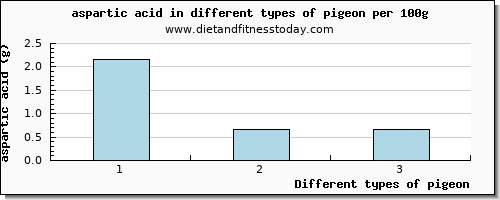
The corresponding nutritional value for pigeon based on our density score out of 100 (ranked by the amount of aspartic acid per 100g) is shown in the below nutritional density chart. 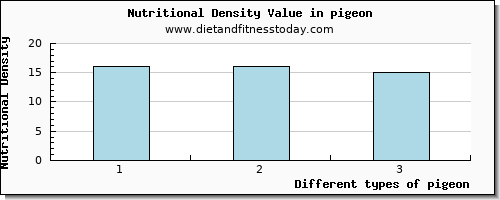
The corresponding Calories for pigeon ranked by the amount of aspartic acid per 100g is shown below in the pigeon calories chart. 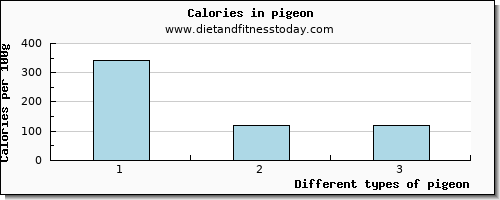
Effect of Preparation and Storage on aspartic acid
The level of aspartic acid can be affected by the method of storage for example canned or frozen and also by the method of preparation for example either raw, cooked or fried. The total food items which are raw is 1 item. The highest amount of aspartic acid from the 1 raw items is in Pigeon peas (red gram), mature seeds, raw where the content is 2.15 g per 100g. The number of food items which are cooked are 2 items. The highest amount of aspartic acid from the 2 cooked items is in Pigeon peas (red gram), mature seeds, cooked, boiled, without salt where the amount is 0.67 g per 100g. Comparing raw and cooked pigeon shows that cooking can change the levels of aspartic acid by 1.48 g in a 100g serving.Average Content for pigeon
The average (or more correctly the arithmetic mean) amount of aspartic acid contained in 100g of pigeon, based on the list below of 3 different items under the general description of pigeon, is 1.16 g of aspartic acid. The averages for the different nutrients are as follows; the average amount of Energy is 195.00 kcal, the average amount of Protein is 11.74 g, the average amount of Total Fat is 0.75 g and the average amount of Carbohydrate is g.Median Amount
The median value of Aspartic acid is found in Pigeon peas (red gram), mature seeds, cooked, boiled, without salt which in 100g contains 0.67 g of Aspartic acid. For this serving the amount of Energy is 121.00 kcal, the amount of Protein is 6.76 g, the amount of Total Fat is 0.38 g and the amount of Carbohydrate is 23.25 g.Highest aspartic acid Content per 100g
Using the list below for the 3 different pigeon nutrition entries in our database, the highest amount of aspartic acid is found in Pigeon peas (red gram), mature seeds, raw which contains 2.15 g of aspartic acid per 100g. The associated percentage of RDA is %. For this 100g serving the Energy content is 343.00 kcal, the Protein content is 21.70 g, the Total Fat content is 1.49 g, the Carbohydrate content is 62.78 g. 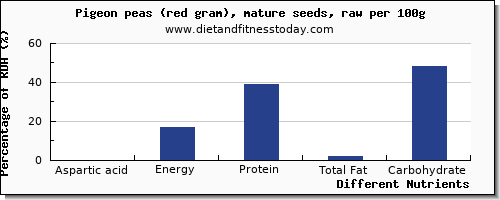
The lowest amount of aspartic acid in 100g is in Pigeon peas (red gram), mature seeds, cooked, boiled, with salt which contains 0.67 g. This gives as percentage of the recommended daily allowance % of the RDA. For this 100g serving the amount of Energy is 121.00 kcal, the amount of Protein is 6.76 g, the amount of Total Fat is 0.38 g, the amount of Carbohydrate is 23.25 g.
The difference between the highest and lowest values gives a aspartic acid range of 1.48 g per 100g. The range for the other nutrients are as follows; 222 kcal for Energy, 14.94 g for Protein, 1.11 g for Total Fat, 0 g for Carbohydrate.
Highest Amount of aspartic acid per Serving
Please remember that the above gives an accurate value in 100g for high aspartic acid foods in your diet. For example 100g of Pigeon peas (red gram), mature seeds, raw contains 2.15 g of aspartic acid. However, there are other factors to consider when you are assessing your nutritional requirements. You should also take into account portion sizes when you are considering the aspartic acid nutritional content.
The food with the highest aspartic acid content per typical serving is Pigeon peas (red gram), mature seeds, raw which contains 4.41 g in 1.000 cup (or 205.00 g). For this serving the Energy content is 703.15 kcal, the Protein content is 44.49 g, the Total Fat content is 3.05 g and the Carbohydrate content is 128.7 g.
Nutritional Information Summary
From the list below you can find a full nutrition facts breakdown for all foods containing aspartic acid which can be scaled for different servings and quantities. We have also sorted our complete nutritional information and vitamin database of over 7000 foods, to give a list of foods high in aspartic acid.
| ||||||||||||||||||||||||||||||||||||||||||||||||||||||||||||||||||||||||||||||||||||||||||||||||||||